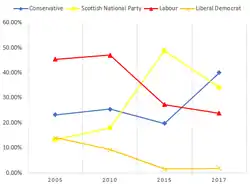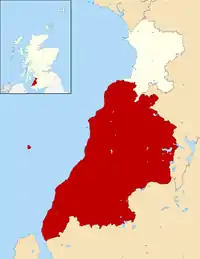Ayr, Carrick and Cumnock (UK Parliament constituency)
Ayr, Carrick, and Cumnock is a county constituency represented in the House of Commons of the Parliament of the United Kingdom. It was created for the 2005 general election from parts of the old Ayr and Carrick, Cumnock and Doon Valley constituencies. It has been represented since 2019 by Allan Dorans of the Scottish National Party.
| Ayr, Carrick and Cumnock | |
|---|---|
| County constituency for the House of Commons | |
 Boundary of Ayr, Carrick and Cumnock in Scotland for the 2005 general election | |
| Subdivisions of Scotland | East Ayrshire, South Ayrshire |
| Population | 93,308 (2011 census) |
| Electorate | 69,299 (2015) |
| Major settlements | Ayr, Girvan, Maybole, New Cumnock |
| Current constituency | |
| Created | 2005 |
| Member of Parliament | Allan Dorans (SNP) |
| Created from | Ayr, Carrick, Cumnock & Doon Valley |
| Overlaps | |
| Scottish Parliament | Ayr, Carrick, Cumnock & Doon Valley, South Scotland |
Boundaries
2005 onwards
As defined by the Fifth Review of UK Parliament constituencies, the constituency covers the South Ayrshire electoral wards of Ayr Whitletts; Ayr Lochside; Ayr Newton; Ayr Craigie; Ayr Central; Ayr Fort; Ayr Forehill; Ayr Masonhill; Ayr Belmont; Ayr Old Belmont; Ayr Rozelle; Ayr Doonfoot and Seafield; Coylton and Minishant; North Carrick and Maybole West; North Carrick and Maybole East; South Carrick; Girvan Ailsa and Girvan Glendoune plus the East Ayrshire electoral wards of Patna and Dalrymple; Dalmellington; Drongan, Stair and Rankinston; Ochiltree, Skares, Netherthird and Craigens; New Cumnock; Cumnock East and Cumnock West.
The constituency covers approximately three-fifths of the South Ayrshire council area and one-fifth of the East Ayrshire council area, with the remaining portion of the South Ayrshire council area being covered by the Central Ayrshire constituency. The remainder of East Ayrshire is covered as part of Kilmarnock and Loudoun.
Constituency profile


Demographics
The 2011 UK Census revealed that the Ayr, Carrick and Cumnock constituency had an above-average unemployment rate at 5.6% compared to the Scottish average of 4.8%, with a significant proportion of residents living in local authority housing at 20.2% compared to the Scottish average of 13.2%. The constituency also had a high proportion of retired people and Church of Scotland Protestants at the Census relative to elsewhere in Scotland, with 19% of those living in the constituency retired (14.9% across Scotland) and 43.3% of constituents recognising their religion as Church of Scotland (32.4% across Scotland). 90% of residents identified their ethnicity as White British, with 99% recognising their ethnicity as White.[1] On indicators such as health, educational attainment, income and social class however the area is more deprived than the national average.
Constituency
The area is mostly affluent however the constituency as a whole is diverse area, Ayr is a large coastal resort town located to the north-west of the constituency, consisting of a mixture of council estates and very affluent areas. The town has traditionally been the strongest part of the constituency for the Conservative Party with them winning most elections in the town area for many years, With the SNP, performing well towards the more industrialised area north of the town and the Conservatives performing stronger in the suburbs in the south of the town like Alloway.
To the south-west of the constituency is the rural region of Carrick, running down the Ayrshire coast between Ayr and Galloway which includes many towns and villages such as Maybole, Turnberry and Girvan. This area has traditionally been more hospitable to the SNP in recent years, in comparison to Ayr, with the Conservatives performing better in rural areas. To the north of Carrick, the village of Coylton has returned a strong vote for Conservative candidates in previous elections. This area has a mix of affluent and less affluent areas.
Further east, the constituency stretches into the south of the East Ayrshire Council area to cover a set of former mining communities around Cumnock and Doon Valley - it's an area which has traditionally returned a much stronger vote for the SNP and weaker Conservative vote in comparison to elsewhere in the Ayr, Carrick and Cumnock, This part of the constituency contains many towns and villages such as Patna, Dalmellington, Bellsbank, and Cumnock which are deprived former mining areas which in recent decades returned a very strong vote for the Labour party though since 2011 The SNP have won most elections within this area.
UK Parliament
In 2005, approximately two-thirds of the former Carrick, Cumnock and Doon Valley constituency was attached to half of the former marginal seat of Ayr to form the Ayr, Carrick and Cumnock constituency. Carrick, Cumnock and Doon Valley had been represented in the UK Parliament by the Labour Party since the 1935 general election, whilst Ayr was represented by the Conservative Party from the 1906 general election until Labour gained the seat during their 1997 landslide electoral victory, from which point onwards the constituency was represented by Labour, with the Conservatives coming in a close second place.
The newly formed Ayr, Carrick and Cumnock constituency was won by Labour's Sandra Osborne at the 2005 general election with a majority of 9,997 votes (22.2%) ahead of the Conservatives. This was reduced slightly to 9,911 votes (21.6%) in 2010, before the constituency fell to the SNP at the 2015 SNP landslide, with SNP candidate Corri Wilson overturning incumbent Labour MP Sandra Osborne's 13,356 vote lead over the SNP (29.1%), securing the constituency with a majority of 11,265 votes (21.6%). Bill Grant of the Conservatives gained the seat at the 2017 snap general election with a majority of 2,774 votes (6.0%) over Corri Wilson of the SNP. In the 2019 General Election, Allan Dorans of the SNP gained the seat from the Conservatives to take the seat again for a second time
Scottish Parliament
The constituency overlaps the Scottish Parliamentary constituencies of Ayr and Carrick, Cumnock and Doon Valley. Ayr has been represented by Conservative MSP John Scott since a by-election in 2000. Carrick, Cumnock and Doon Valley has been represented by the SNP since the 2011 Scottish Parliamentary election. The current MSP for Carrick, Cumnock and Doon Valley is Jeane Freeman.
Local Council elections
The Conservatives have been the largest party on South Ayrshire Council since 2003, taking control of the Council in 2006. The Ayr West ward has traditionally been the strongest part of the Council for the Conservative party, with Ayr East also returning a considerable Conservative vote. More recently, the party have also gained votes in the more rural area of Carrick to the south of Ayr, with the SNP forming the largest party in the Ayr North ward.
The SNP have formed the largest party on East Ayrshire Council since 2012, however, Labour remain the largest party in Cumnock and Doon Valley, the part of East Ayrshire covered by the Ayr, Carrick and Cumnock parliamentary constituency.
Members of Parliament
| Name | In office | Party | ||
|---|---|---|---|---|
| Sandra Osborne | 1 May 1997 | 30 March 2015 | Labour | |
| Corri Wilson | 8 May 2015 | 3 May 2017 | Scottish National Party | |
| Bill Grant | 4 May 2017 | 7 November 2019 | Conservative | |
| Allan Dorans | 12 December 2019 | Scottish National Party | ||
Election results

Elections in the 2010s
| Party | Candidate | Votes | % | ±% | |
|---|---|---|---|---|---|
| SNP | Allan Dorans | 20,272 | 43.5 | +9.4 | |
| Conservative | Martin Dowey | 17,943 | 38.5 | -1.6 | |
| Labour | Duncan Townson | 6,219 | 13.3 | -10.6 | |
| Liberal Democrats | Helena Bongard | 2,158 | 4.6 | +2.7 | |
| Majority | 2,329 | 5.0 | N/A | ||
| Turnout | 46,592 | 64.7 | -0.2 | ||
| SNP gain from Conservative | Swing | +5.5 | |||
| Party | Candidate | Votes | % | ±% | |
|---|---|---|---|---|---|
| Conservative | Bill Grant | 18,550 | 40.1 | +20.3 | |
| SNP | Corri Wilson | 15,776 | 34.1 | -14.7 | |
| Labour | Carol Mochan | 11,024 | 23.9 | -3.4 | |
| Liberal Democrats | Callum Leslie | 872 | 1.9 | +0.3 | |
| Majority | 2,774 | 6.0 | N/A | ||
| Turnout | 46,296 | 64.9 | -6.6 | ||
| Conservative gain from SNP | Swing | ||||
| Party | Candidate | Votes | % | ±% | |
|---|---|---|---|---|---|
| SNP | Corri Wilson | 25,492 | 48.8 | +30.8 | |
| Labour | Sandra Osborne | 14,227 | 27.3 | −19.8 | |
| Conservative | Lee Lyons | 10,355 | 19.8 | −5.7 | |
| UKIP | Joseph Adam-Smith[7] | 1,280 | 2.5 | New | |
| Liberal Democrats | Richard Brodie | 855 | 1.6 | −7.7 | |
| Majority | 11,265 | 21.5 | N/A | ||
| Turnout | 52,209 | 71.5 | +8.9 | ||
| SNP gain from Labour | Swing | +25.4 | |||
| Party | Candidate | Votes | % | ±% | |
|---|---|---|---|---|---|
| Labour | Sandra Osborne | 21,632 | 47.1 | +1.7 | |
| Conservative | Bill Grant | 11,721 | 25.5 | +2.3 | |
| SNP | Chic Brodie | 8,276 | 18.0 | +4.8 | |
| Liberal Democrats | James Taylor | 4,264 | 9.3 | −4.8 | |
| Majority | 9,911 | 21.6 | -0.6 | ||
| Turnout | 45,893 | 62.6 | +1.3 | ||
| Labour hold | Swing | −0.3 | |||
Elections in the 2000s
| Party | Candidate | Votes | % | ±% | |
|---|---|---|---|---|---|
| Labour | Sandra Osborne | 20,433 | 45.4 | -5.9 | |
| Conservative | Mark Jones | 10,436 | 23.2 | -1.6 | |
| Liberal Democrats | Colin Waugh | 6,341 | 14.1 | +6.9 | |
| SNP | Chic Brodie | 5,932 | 13.2 | -0.5 | |
| Scottish Senior Citizens | Donald Sharp | 592 | 1.3 | N/A | |
| Scottish Socialist | Murray Steele | 554 | 1.2 | -1.2 | |
| Socialist Labour | James McDaid | 395 | 0.9 | +0.3 | |
| UKIP | Bryan McCormack | 365 | 0.8 | +0.7 | |
| Majority | 9,997 | 22.2 | N/A | ||
| Turnout | 45,048 | 61.3 | N/A | ||
| Labour win (new seat) | |||||
References
- 'Ayr, Carrick and Cumnock'
- "UK Parliamentary Elections". South Ayrshire Council. South Ayrshire Council. Retrieved 14 November 2019.
- "Ayr, Carrick & Cumnock parliamentary constituency - Election 2019". Retrieved 13 December 2019.
- "Election Data 2015". Electoral Calculus. Archived from the original on 17 October 2015. Retrieved 17 October 2015.
- http://www.south-ayrshire.gov.uk/documents/ayr%20carrick%20cumnock%20results.pdf
- http://ukpollingreport.co.uk/2015guide/ayrcarrickandcumnock/
- "Election Data 2010". Electoral Calculus. Archived from the original on 26 July 2013. Retrieved 17 October 2015.
- "Election Data 2005". Electoral Calculus. Archived from the original on 15 October 2011. Retrieved 18 October 2015.
- "Election 2005". BBC. Retrieved 28 December 2016.
